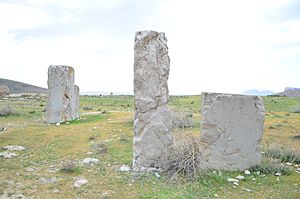Istakhr facts for kids
|
|

Columns at Istakhr
|
|
| Region | Fars Province |
|---|---|
| Coordinates | 29°58′51″N 52°54′34″E / 29.98083°N 52.90944°E |
| Type | Settlement |
| History | |
| Founded | Very shortly after the decline of Persepolis (second half of the 4th century BC) |
| Periods | Classical antiquity to Late Middle Ages |
Istakhr (Middle Persian: Stakhr, Persian: اصطخر Estakhr) was an ancient city in Fars province, about 5 kilometers (3 miles) north of Persepolis in southwestern Iran. It was a very important place for many centuries.
Contents
Istakhr: An Ancient City in Iran
Istakhr was a significant city in ancient Iran. It was located in the Fars province, which is a region known for its rich history. The city was built very soon after the famous city of Persepolis started to decline. This happened in the second half of the 4th century BC.
Location and Importance
Istakhr's location was key to its importance. It was only a short distance from Persepolis, which was once the capital of the mighty Achaemenid Empire. Because of this closeness, Istakhr often played a role in the history of the region. It served as a center for different empires and cultures over many hundreds of years.
Istakhr Through the Ages
Istakhr saw many changes throughout history. It was important during the Classical antiquity period and continued to be so until the Late Middle Ages.
After the Achaemenids
After the Achaemenid Empire fell, Istakhr became a local capital. It was a center for the rulers of Persis. These rulers were called frataraka. They minted their own coins in Istakhr. This shows that the city had its own power and economy.
Sasanian Empire
Istakhr became even more important during the Sasanian Empire. This empire ruled Persia from the 3rd to the 7th century AD. Istakhr was a royal city for the Sasanian kings. It was a place where they kept important records and treasures. The city was also a strong center for the Zoroastrian religion. This was the main religion of the Sasanian Empire.
Later History
The city continued to be important even after the Sasanian Empire. However, it faced many challenges. It was damaged during different conflicts. Over time, its importance slowly faded. Today, only ruins remain, but they tell a story of a once-great city.
Images for kids
-
Baydad, the first recorded frataraka of Persis, early 3rd century BC. Coin minted in Istakhr. Obv: Baydad with short beard, mustache, earring and satrapal headdress (kyrbasia). Rev: Baydad standing to the left of a fire temple of Ahura Mazda, standard located on the other side of the temple
-
Ardashir I, as King Artaxerxes (Ardaxsir) V of Persis. Circa CE 205/6-223/4, minted in Istakhr. Obv: Bearded facing head, wearing diadem and Parthian-style tiara. Rev: Bearded head of Papak, wearing diadem and Parthian-style tiara.
See also
 In Spanish: Istajr para niños
In Spanish: Istajr para niños







